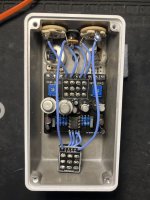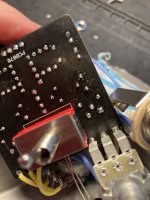jwyles90
Well-known member
Hey all,
Just put together a Twin Face build recently and while it technically "works", it's making some weird noises in the process. The silicon side is super noisy, and has a decent amount of hiss in the noise floor. For both silicon and germanium, if my guitar volume knob is at anything less than 10 there's basically no signal that comes through, and if I roll the volume all the way down on the guitar it just makes this loud buzzing noise instead of no noise at all. I thought initially it might be the guitar itself, but I tried it with multiple and the issue was present each time. I also noticed that it does something similar with my guitar tone knobs. Rolling them down to zero actually makes the signal sound more intense somehow, while anything in between doesn't seem to have a discernable difference from 0 to 10.
Any thoughts on what could be causing this? I know that fuzz faces can be kinda finicky at times, but this feels a little too finicky...

Just put together a Twin Face build recently and while it technically "works", it's making some weird noises in the process. The silicon side is super noisy, and has a decent amount of hiss in the noise floor. For both silicon and germanium, if my guitar volume knob is at anything less than 10 there's basically no signal that comes through, and if I roll the volume all the way down on the guitar it just makes this loud buzzing noise instead of no noise at all. I thought initially it might be the guitar itself, but I tried it with multiple and the issue was present each time. I also noticed that it does something similar with my guitar tone knobs. Rolling them down to zero actually makes the signal sound more intense somehow, while anything in between doesn't seem to have a discernable difference from 0 to 10.
Any thoughts on what could be causing this? I know that fuzz faces can be kinda finicky at times, but this feels a little too finicky...



